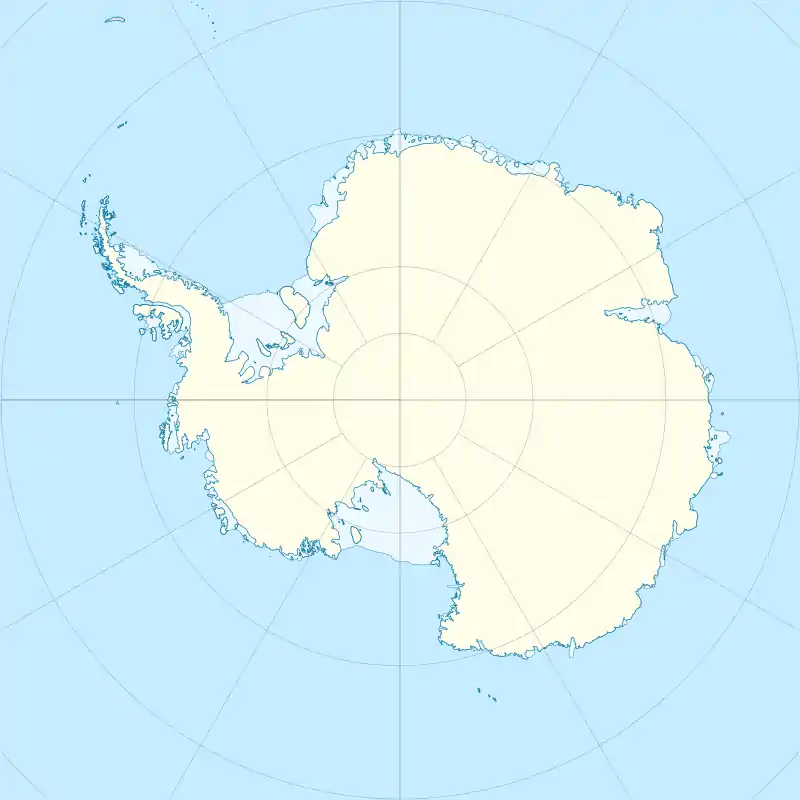Lumus Rock
Lumus Rock is a rock located 4 nautical miles (7 km) west-northwest of Sooty Rock, marking the southwestern extremity of the Wilhelm Archipelago off the Graham Coast of the Antarctic Peninsula, Antarctica. It was discovered by British Graham Land Expedition (BGLE), 1934–37, and named "Lumus Reef" after one of the expedition cats, the only one to survive the Antarctic winter. The BGLE naming has been accepted because of long use, though a change in generic term, from reef to rock, was made on recommendation by the UK Antarctic Place-Names Committee in 1971.[1] The rock is situated roughly midway between Anvers and Renaud Island at 7.8 miles (12.6 km) west-northwest of the Betbeder Islands,[2] in the Hugo Island Trough,[3] belonging to the Palmer Deep, an inner shelf structural depression.[4]
 Lumus Rock Location of Lumus Rock in Antarctica | |
| Etymology | Ship's cat Lummo |
|---|---|
| Geography | |
| Location | Antarctica |
| Coordinates | 65°13′S 65°18′W |
| Archipelago | Wilhelm Archipelago |
| Adjacent bodies of water | Southern Ocean |
| Administration | |
| Administered under the Antarctic Treaty System | |
| Demographics | |
| Population | Uninhabited |
Etymology
Lumus Rock was named after the ship's cat, Lummo, present on the Penola, a three-masted schooner of the British Graham Land Expedition, visiting the Wilhelm Archipelago from 1934 to 1937. Lummo survived the three year expedition and died in Woking, Surrey, England during the Second World War.[5]
Geology
The Antarctic Peninsula, located on the Antarctic Plate, and its offshore islands are probably composed of Late Paleozoic rocks that are strongly folded.[6] The geological map of Antarctica lists Mesozoic volcanic rocks and granitoids in the area.[7]
References
- "Lumus Rock". Geographic Names Information System. United States Geological Survey. Retrieved 2017-10-13.
- Sailing Directions (Planning Guide & Enroute), Pub. 200: Antarctica (PDF). Sailing Directions. United States National Geospatial-Intelligence Agency. 2017. p. 151.
- Domack et al., 2005, p.2
- Sjunneskog & Taylor, 2002, p.2
- Roberts, Patrick (2006). "Antarctic Cats - 19th and early 20th century expeditions". Retrieved 2017-10-13.
- Elliot, 1975, p.74
- Tingey, 1991, p.31
Bibliography
- Domack, Eugene; David Amblàs; Robert Gilbert; Stefanie Brachfeld; Angelo Camerlenghi; Michele Rebesco; Miquel Canals, and Roger Urgeles. 2005. Subglacial morphology and glacial evolution of the Palmer deep outlet system, Antarctic Peninsula. Geomorphology 01788. 1–18. Accessed 2017-10-13.
- Elliot, David H. 1975. Tectonics of Antarctica: A Review. American Journal of Science 275-A. 45–106. Accessed 2017-10-13.
- Sjunneskog, Charlotte, and Fiona Taylor. 2002. Postglacial marine diatom record of the Palmer Deep, Antarctic Peninsula (ODP Leg 178, Site 1098) 1. Total diatom abundance. Paleoceanography 17. 1–8. Accessed 2017-10-13.
- Tingey, R.J. 1991. Commentary on schematic geological map of Antarctica Scale 1:10 000 000. BMR Bulletin 238. 1–31. Accessed 2017-10-13.
 This article incorporates public domain material from the United States Geological Survey document: "Lumus Rock". (content from the Geographic Names Information System)
This article incorporates public domain material from the United States Geological Survey document: "Lumus Rock". (content from the Geographic Names Information System)
Further reading
- Harris, C.M., Lorenz, K., Fishpool, L.D.C., Lascelles, B., Cooper, J., Coria, N.R., Croxall, J.P., Emmerson, L.M., Fijn, R.C., Fraser, W.L., Jouventin, P., LaRue, M.A., Le Maho, Y., Lynch, H.J., Naveen, R., Patterson-Fraser, D.L., Peter, H.-U., Poncet, S., Phillips, R.A., Southwell, C.J., van Franeker, J.A., Weimerskirch, H., Wienecke, B., & Woehler, E.J. 2015. Important Bird Areas in Antarctica, 1–301. BirdLife International and Environmental Research & Assessment Ltd., Cambridge. Accessed 2017-10-13.
.svg.png.webp)